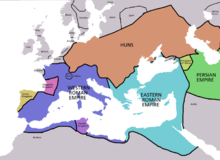| Millennium: | 1st millennium |
|---|---|
| Centuries: | |
| Decades: | |
| Years: |
| 450 by topic |
|---|
| Leaders |
| Categories |
| Gregorian calendar | 450 CDL |
| Ab urbe condita | 1203 |
| Assyrian calendar | 5200 |
| Balinese saka calendar | 371–372 |
| Bengali calendar | −143 |
| Berber calendar | 1400 |
| Buddhist calendar | 994 |
| Burmese calendar | −188 |
| Byzantine calendar | 5958–5959 |
| Chinese calendar | 己丑年 (Earth Ox) 3147 or 2940 — to — 庚寅年 (Metal Tiger) 3148 or 2941 |
| Coptic calendar | 166–167 |
| Discordian calendar | 1616 |
| Ethiopian calendar | 442–443 |
| Hebrew calendar | 4210–4211 |
| Hindu calendars | |
| - Vikram Samvat | 506–507 |
| - Shaka Samvat | 371–372 |
| - Kali Yuga | 3550–3551 |
| Holocene calendar | 10450 |
| Iranian calendar | 172 BP – 171 BP |
| Islamic calendar | 177 BH – 176 BH |
| Javanese calendar | 335–336 |
| Julian calendar | 450 CDL |
| Korean calendar | 2783 |
| Minguo calendar | 1462 before ROC 民前1462年 |
| Nanakshahi calendar | −1018 |
| Seleucid era | 761/762 AG |
| Thai solar calendar | 992–993 |
| Tibetan calendar | 阴土牛年 (female Earth-Ox) 576 or 195 or −577 — to — 阳金虎年 (male Iron-Tiger) 577 or 196 or −576 |

Year 450 (CDL, CCCCL) was a common year starting on Sunday (link will display the full calendar) of the Julian calendar, the 450th Year of the Common Era (CE) and Anno Domini (AD designations, the 450th year of the 1st millennium, the 50th year of the half of 5th century, and the 1st year of the 450s decade. At the time, it was known as the Year of the Consulship of Valentinianus and Avienus (or, less frequently, year 1203 Ab urbe condita). The denomination 450 for this year has been used since the early medieval period, when the Anno Domini calendar era became the prevalent method in Europe for naming years.